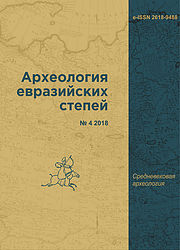ALUSTON IN THE GOLDEN HORDE PERIOD
Keywords:
Tavrika, Gotiya, Aluston, Golden Horde, Genoese Gazaria, 13th–14th centuries, ceramic areasAbstract
Written sources and the materials of archaeological researches in 1984–1994 allowed to distinguish the period in the history of Aluston when it was joined the Crimean ulus of The Golden Horde. Chronologically this time is determined within 1278–1365. That certain period is marked by signifi cant innovations in material culture: the appearance of coin denominations of the Horde (pūl, dirham, saum), artistic glazed ceramics (both exports and local production), various jewelry. In the layers of the turn of the 13th–14th and 14th–15th centuries there were found stucco and pottery vessels (hums, jars, pots, pitchers) which were not previously found on the monument. This points to the appearance of the new (the Adygeyan?) population in Aluston which arrived from the North Caucasus. On the investigated territory of Aluston of 3,600 sq. m there have been discovered more than 100 rooms of the 13th–15th centuries. In seven of them there have been revealed the layers of local fires in 60–80–ies of the 14th century. However, only three rooms have not been restored. For 1365–1386 there is a struggle between the Genoese and the Tartars of the coast of Gothia, which, together with Aluston was included in the Genoa Gazaria under the treaty of 1387. In addition, in 1384 (and for a decade) some confl icts were breaking out between the Orthodox hierarchs of Gothia, Sugdaea and Kherson for the right of collecting the kanonikon from the population of several parishes of the seaside Gothia. Probably these events are associated the fires of the second half of the 14th century in the territory of Aluston.
References
Бочаров С.Г. Заметки по исторической географии Генуэзской Газарии XIV−XV вв. Южный берег Крыма // О древностях Южного берега и гор Таврических. Киев: Стилос, 2004. С. 186−204.
Мыц В.Л. Отчёт об археологических исследованиях средневековых укреплений Алустон и Фуна в 1986 г. // Архив ИА НАНУ. №1986/25.
Мыц В.Л. Отчёт об археологических исследованиях средневековой крепости Алустон в 1987 г. // Архив ИА НАНУ №1987/27.
Мыц В.Л. Завоевание поздневизантийской Таврики монголами: историко–археологический контекст катастрофы последней четверти XIII века // PaxMongolica и Евразийские потрясения XIII−XIV веков. Stratum Plus. Археология и культурная антропология. №6. СПб.-Кишинёв-Одесса-Бухарест, 2016. С. 69−106.
Тесленко И.Б. Производство поливной керамики в крепости Алустон (Крым) // Поливная керамика Средиземноморья и Причерноморья X−XVIII вв. Киев: Стилос, 2005. С. 324−348.
Тесленко И.Б. Комплекс керамики из раскопок усадьбы золотоордынского периода на территории средневекового городища в Алуште (Крым) // Поливная керамика Средиземноморья и Причерноморья в X−XVIII вв. Т.2. / Под ред. С.Г. Бочарова, В. Франсуа, А.Г. Ситдикова. Stratum Plus. Археологические источники Восточной Европы. Казань–Кишинёв, 2017.С. 387−407.
Balard M. 1978. La Romanie Genoise (XII–e–debut du XVe siècle). Vol.2, Genes; Rome: Ecole Francaise de Rome.
Basso E. Il “bellum de Sorchati” ed i trattati del 1380–1387 tra Genova e l’Ordo d’Oro// Studi genuensi N.S. 1991, 8. P.11–26.
Musso G. 1968. Note d’archivio sulla “Massaria” di Caff a // Studi Genuensi. Vol.V: 1964–65, 62–98.
Vigna A. 1879. Codice diplomatico delle colonie Tauro–Liguri, 1453–1475 // Atti Societa Ligure Storia Patria. Vol.VII, fasc.II, parte II. Genova.

Downloads
Published
How to Cite
Issue
Section
License
Copyright (c) 2018 V. L. Myts

This work is licensed under a Creative Commons Attribution-NonCommercial 4.0 International License.







